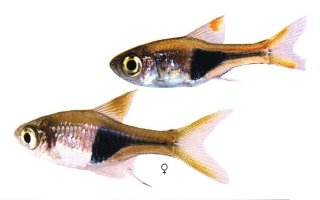Individual Fish Description Page


This page will give a completely detailed profile of the
selected fish, from A to Z. The profiled fish will be
chosen randomly by Badman, and will come from the complete
genre of tropical fish. I will try to up-date the profile
on a monthly basis. If you have a specific fish you want
profiled please vote for it in the favorite fish poll on the main index page.


RASBORA HETEROMORPHIA
Quick stats:
| size: | 1 3/4 inches |
| tank: | 20 inches |
| strata: | top, middle |
| pH: | 5 to 7 |
| Hardness: | soft to medium |
| temperature: | 73o to 82o f |
Classification:
| Order: | Cypriniformes |
| Sub-order: | Cyprindei |
| Family: | Cyprindae |
| Genera: | Rasbora |
Common name:
Harlequin Rasbora, Red Rasbora, and Harlequin
Distribution:
Thailand, Eastern Sumatra and the Malay Penisula
General Body Form:
Different from most other Rasbora species, the Harlequin is stocky and tall with a convex belly area. Males are more slender than the females. they can reach a length of around one and three quarter inches (4.5cms)
Coloration:
Perhaps the most characteristic feature of this species is the triangular shaped, Blackish Blue marking, which begins wide in the center of the body and becomes narrower as it extends back to the start of the Caudal fin. In the females the lower front of the Triangle is often indistinct, while in the males it has a sharp edge that extends down toward the belly area. The dorsal fin is a Red color with a yellow tip. The upper and lower tips of the Caudal fin are a bright Red with the inside rays being a pale Yellow. The Base coloration of the body is a silver color and the sides range from a Pink all the way to a Copper color.
Maintenance:
All Rasbora species are peaceful and unaggressive and can be kept with fish of similar temperament. They are strong swimmers and in nature prefer to be in small schools. They like to stay in the upper areas of the aquarium. Your tank should provide plenty of open space for swimming as well as some dense plantings to serve as shelter.The water temperature should be kept around 76f. Rasboras prefer soft water and if possible you should use a peat filter bag in your filter, (Tetras will benefit also ) They will eat flake, frozen as well live food.
Biotope:
Still, usually clear waters in Southeast Asia
Breeding:
Many species of Rasbora will breed without too much difficulty, spawning freely in soft, neutral or slightly Acidic water. Unfortunately Rasbora Heteromorpha is not one of these. The water should be very soft with a hardness of 1.5 to 2.5 DH and a Ph of around 6.0. A long breeding tank is also beneficial with a dark substrate.
The mating consists of the pair lying upside down under a leaf or similar with the male curling his tail around the female. It may take several days in the spawning tank before mating takes place. The parents will eat their own eggs so it is very important to remove them from the tank right away. After the parents are removed you should carefully lower the water to a depth of four or five inches. The eggs will hatch in 24 to 30 hours and in three to five days the fry become free swimming. The young should be fed on baby brine shrimp and other small foods. growth is fairly rapid.




back to the fish profile page.

Email:
badman2nd@hotmail.com






